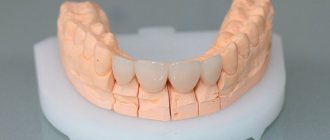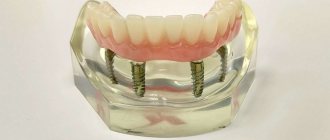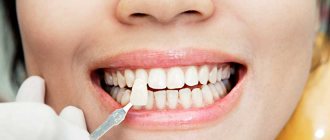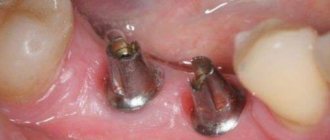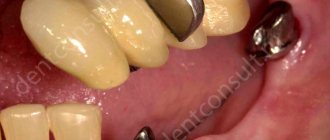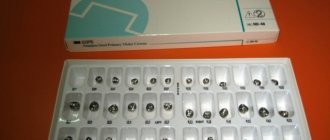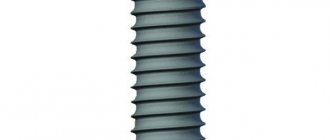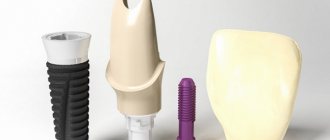Indications and contraindications
Metal-ceramic crowns are used for:
- Restoring the shape, function and color of teeth damaged by caries, trauma, fluorosis, taking medications, etc.
- Increased abrasion of enamel;
- Correction of dental anomalies that cannot be straightened using orthodontic methods;
- Elimination of both single dental defects and 2-3 adjacent teeth;
- Supports for removable dentures.
The installation of metal-ceramics is excluded in case of defects in the crown of the abutment tooth (if it is thin-walled, low, etc.), severe form of periodontitis, with large defects in the row (if more than 4 teeth are missing), if the tooth has living pulp.
Installation of metal-ceramic crowns before and after
Tips for restoring teeth
In order for the tooth restoration to take place with the highest quality, you must remember the following rule. Filling is performed when the tooth is 1/3 destroyed. If the defect is extensive, veneers or inlays are used to restore function. If more than half of the tooth tissue is damaged, orthodontists recommend installing a denture.
The service life of the crown is indicated by the manufacturer and directly depends on the material from which it was made. As a rule, the durability of metal-ceramic products is from 7 to 10 years, gold products - from 15 to 20 years, zirconium crowns - over 20 years.
Advantages and disadvantages of metal ceramics
- Identity of metal-ceramic crowns to natural teeth. They can be used to bite and chew solid food, and the high aesthetic qualities of the crowns allow them to be installed even on the front teeth.
- Hygiene. Much less stone and microbial plaque settles on the surface of metal ceramics than on natural enamel and metal crowns.
- Durability. If a crown is made using modern techniques and from high-quality material, it can last 12-15 years. Throughout this entire period, the crown “stays” exactly on the tooth, caries does not develop under it and no changes occur in the gum.
Metal-ceramics is not without its disadvantages. So, before installation, the abutment tooth must be ground and depulped. Carrying out these manipulations by a non-professional is fraught with the development of pulpitis. Some clinics offer fairly low prices for metal-ceramic crowns without shoulder masses. Such crowns look somewhat unaesthetic, because... There is a dark line along the edge of the prosthesis. In Dentistry on Amurskaya, crowns are used only using shoulder masses. The shoulder mass protects the gums from contact with metal and significantly increases the aesthetic properties of the crown.
Comparison with fillings
Dental crowns are often confused with fillings. These are completely different products, despite the fact that they are used to restore the visual qualities and shape of problem teeth.
The mechanical impact of chewing is transmitted to the walls of the filled tooth and sometimes leads to its fracture. In addition, large fillings can also cause fractures. The crown is made in the laboratory and attached to the top of the tooth. Under the crown it will always be intact, despite mechanical stress.
Benefits of a dental crown:
- The strength of the crown is significantly higher compared to the materials used for filling.
- Crowns rarely crack. Even if this happens, it can be restored and repaired. When filling, there is no such option.
- During chewing, pressure from the surface is transferred to the root. The filling distributes the mechanical impact on the preserved tooth fragments, and fractures often occur.
Metal ceramics in Dentistry at Amazing Prices
Qualified dentists at the clinic on Amurskaya perform prosthetics with metal-ceramic crowns using high-quality consumables (metal alloys and durable porcelain coatings) and high-precision equipment.
The process of making and installing crowns requires 2 to 4 visits to the doctor. After preparatory measures (preparation of the abutment tooth), an impression is taken from both jaws, on the basis of which a plaster model of the human dentition is made in a dental laboratory. Then, based on the model, the metal frame of the crown is recreated, on which the fissure pits, tubercles and other anatomical features of the tooth are displayed. After fitting, this metal base is covered with ceramic mass and fired.
Thanks to the painstaking work of our specialists, metal-ceramic crowns are durable and provide patients with a beautiful smile for many years.
Metal dental crowns
Metal dental crowns are considered obsolete, which is due to the emergence of more modern analogues. Despite this, this option of prosthetics has remained popular, which is explained by many advantages.
Depending on the manufacturing method, there are the following types of metal crowns:
- Cast. Manufactured taking into account individual characteristics. The product is cast from a metal alloy in exact accordance with the natural size and shape of the patient's real teeth.
Cast crowns.
- Stamped. They are made on the basis of a workpiece of standard sizes for a specific tooth. Today this technology is practically not used.
Stamped crowns.
The material used for manufacturing is an alloy containing titanium, silver, nickel and cobalt. Sometimes gold is added to the composition. The degree of strength depends on the ratio of these materials. The optimal alloy option is selected depending on the required size, as well as the location of the prosthetic tooth.
Advantages:
- Fast production
- Strength
- Durability
- Possibility of polishing
- Affordable price
- Possibility of applying artificial enamel
Metal crowns are used in the treatment or prosthetics of distal teeth. They are also actively used as a support when installing removable dentures.
The disadvantages include:
- Aesthetic unattractiveness
- High cost (if using dental gold)
- Possible allergic reactions to the alloy
- The need to install crowns on adjacent teeth made of the same alloy
Thus, metal crowns have many advantages and can be used to replace molars, but prosthetics of the front teeth using them is considered impossible.
Important to remember! Before fixing metal crowns, you must make sure that there is no allergy to the selected material.
The minimum cost of metal crowns is from 3,500 rubles . The average price for a product, taking into account the cost of installation, is from 5,000 rubles .
Cost of metal-ceramic crowns
| Name | Price, rub.) | Additional Information |
| Metal-ceramic crown | 2950/3950/4950 | Made in Germany, Japan |
The price of a crown, as a rule, consists of the cost of the crown itself, as well as fixation of the crown with permanent cement and impressions. Unfortunately, advertising often uses tricks in which the price is indicated, and then it turns out that it is necessary to add to it, for example, “the work of a doctor” and other similar elements that increase the price of the original price by two or more times.
But patients are interested in the final cost, the so-called turnkey price. And it is right. Because when comparing prices for metal-ceramic crowns in Moscow, it is fair to rely on the final real costs of identical work in different clinics.
Let's take a look at pricing at Amazing Price Dentistry. At a price of 2,950 rubles for a crown made from German-made materials, you need to add 1,200 rubles for impressions and 300 rubles for fixation, that is, one metal-ceramic crown will cost 4,550 rubles. It seems that the price is less than the minimum prices in Moscow (6,000 rubles) by only 1,450 rubles.
But if you calculate, for example, 2 bridges of 4 units with two supports in each, it comes out to 23,600 for crowns, 1,200 for fixation and 1,200 for casts. Only 26,000 for 8 teeth, that is, 3,250 rubles each!
Thus, the price of a turnkey metal-ceramic crown made of German material at Amazing Price Dentistry is almost half the minimum price (6,000 rubles) in Moscow for similar work.
Metal-ceramic crowns
What does a crown look like and what problems does it solve?
What is a dental crown? This is a kind of structure that serves as a substitute for the part of the tooth located above the edge of the gum. The product is created in a laboratory and then fixed with dental cement. How many teeth are crowns placed on? Typically, this design is used for single restorations, but in the absence of several units in a row, bridges are installed.
Many people are interested in the question: are crowns placed on living teeth? Yes, such structures allow you to save a tooth, even if it is destroyed, and can also be fixed as supporting elements for the subsequent fixation of a bridge or clasp prosthesis. Also, such products can be installed on implants. To understand what a dental crown looks like, just look at the photo below.
This is what dental crowns look like
Typically, this treatment method is used in cases where there is more than 70% destruction1. In such a situation, there is no point in using fillings or, for example, microprosthetics with inlays. Due to the inability to ensure proper distribution of chewing pressure, the filling will soon begin to deteriorate, which will lead to the need to remove it. For this reason, the choice of product is made by the attending physician based on the available data on the clinical picture.
Crowns for front teeth
Crowns for the front teeth have their own characteristics and they are associated precisely with their location in the oral cavity. In addition to strength and reliability, they are expected to be more aesthetically pleasing.
Simply put, people not only bite and partially chew with their front teeth, but also smile. That is, the front teeth are partly responsible for the function of communication and interpersonal communication. And how beautiful the front teeth will look during a conversation and smile depends on the general perception of a person by others.
Two simple and obvious signs of the beauty of the front teeth are as follows:
- the horizontal position should be strictly parallel to the level of the eyes, or rather the line connecting the middle of the pupils;
- The vertical line between the central incisors should run exactly along the middle of the face, the guideline for this is the middle of the nose.
The third sign of aesthetic front crowns is symmetry, which means that the teeth on the left should follow the shape of the teeth on the right and vice versa - they should be similar in shape and size on both sides.
And finally, one more important point - due to the fact that the front teeth have a thin cutting edge, the risk of chipping the ceramic layer from high loads increases. In order to greatly reduce the likelihood of mechanical damage, it is necessary to carefully correct the bite using special articulation paper, similar to ordinary carbon paper.
Care
If you have dentures in your mouth, you should practice more careful oral hygiene. With a single crown, it will be enough to use a toothbrush, floss and toothpaste.
If you have bridges, hygiene can be significantly more complicated. Food often gets clogged under such a structure, which can sometimes be difficult to remove when using a brush or even thread.
But an irrigator can handle this well. A stream of water is supplied from it under pressure, which washes away food debris, soft plaque, and at the same time massages the gums.
Possible problems after installing crowns:
- The occurrence of caries under the crown. This occurs due to the formation of inflammation under the prosthesis due to poor cleaning of the dental canals or poor installation of the structure.
- Mobility of the prosthesis - can occur when poor cement is used to secure it or the shape is poorly calculated.
Crowns for chewing teeth
The main load when chewing falls on the back teeth. This is associated with increased strength and reliability requirements for crowns on chewing teeth.
Due to the large width and extent of the chewing surface and the correspondingly larger contact area of the upper and lower teeth, a decrease in pressure per unit surface can be assumed.
In simple terms, the risks of chipping the ceramic surface in the crowns in question are not great, and the only special requirement is that there is a certain relief on the contact surfaces of the upper and lower teeth, the so-called cusps, the presence of which ensures effective chewing of food during various lateral movements of the lower jaw.
Combined crowns/bridges –
Such crowns are called metal-plastic (Fig. 14-15). They, like cast crowns, are made using a solid casting method from a cobalt-chrome alloy, but the front surface is additionally lined with white plastic. Their advantages include acceptable aesthetics. The price for metal-plastic crowns will be from 7,000 rubles per unit.
Disadvantages of metal-plastic crowns –
- Plastic in the oral cavity quickly loses its aesthetic properties, and over time, the white color of the plastic changes to gray. In addition, plastic tends to absorb liquid and swell slightly. This leads to the fact that over time the plastic begins to emit the smell of unbrushed teeth.
- Metal-plastic crowns are also not very reliable: if the teeth are clenched tightly or while chewing, the plastic lining may simply fall out.
- Plastic is not very good for health (especially for allergy sufferers), because... There is always some amount of chemically active monomer remaining in plastic, which is released for a very long time.
Combined bridges –
Because The metal frame of metal-ceramics, as well as solid-cast bridges, are made on the same cast metal frame - different types of crowns can be combined in one bridge. For example, you need to make a bridge of 3 units supporting teeth 5-7. In this case, the nearest 1-2 crowns falling into the smile line can be made with metal-ceramic, and the distant crowns can be made of solid casting (Fig. 16).
Dentists and dental technicians are not very fond of such designs, because... this reduces their cost. And if they tell you that this cannot be done, then this will only indicate the doctor’s reluctance.
Metal-ceramic crown with shoulder mass
A very common situation occurs when the metal frame is visible along the edge of the metal-ceramic crown and a dark gray strip is visible along the gums.
In such cases, shoulder mass is used. The technology is as follows: the edge of the metal frame is removed and laid out with a particularly strong special ceramic mass. It turns out very beautifully and you can’t see the gray stripes along the edge of the crown.
And here the question may arise, why not use simple ceramics around the edges instead of some special one? The answer is that the ceramic mass, without support from a metal frame, is very fragile and will chip and break. The shoulder mass has increased mechanical properties, allowing it to be used without metal support. This raises the second question - why not make crowns entirely from the shoulder mass? The answer is that it is possible, but the cost of the shoulder mass is several times higher than the usual mass, and with continuous use the crown would become more expensive by an order of magnitude.
Therefore, additional payment is required for crowns with shoulder mass, but as a rule this is significantly justified by the achieved aesthetic result.
Which ones are better to choose?
Clinics offer many options for crowns, the key difference between which is the material used. It is this parameter that largely determines the quality, cost and indications for the use of a particular crown. Another very important nuance that also affects the quality parameters is the manufacturing technology of the product.
Types of crowns
- Metal crowns.
They are considered hopelessly outdated, but are still used in many clinics. They can be made from various alloys (cobalt-chromium, titanium, and so on). Options with plating (for example, “gold-like”) or with plastic lining are possible. They are made using solid casting technology: the structure is cast entirely from a tooth impression. The stamping technique can also be used. - Crowns made of precious metals.
As a rule, these are alloys based on gold or platinum. Crowns made from pure material are not used due to high cost and functionality problems. The alloy allows you to achieve the necessary strength and maintain biocompatibility. Manufactured using solid casting technology. - Metal-ceramic crowns.
The most common products that consist of a metal frame and ceramic coating. First, the frame is cast, then a layer of ceramic is applied, which can be manufactured using computer modeling. - All-ceramic crowns.
Metal-free ceramic crowns. Due to its biological inertness, this material is considered one of the safest for soft tissues. Manufactured using firing technology (on a refractory model or platinum foil); ceramic pressing method (surface painting technique or layering technique); on a milling machine using CAD/CAM computer modeling. - Zirconium dioxide crowns.
Some classify such crowns as metal-free products, but this is not so. Zirconium is a metal, but it is much more aesthetically pleasing and safe compared to others. They are manufactured using computer modeling using special milling equipment. There are two types of zirconium dioxide crowns: monolithic (entirely made of zirconium dioxide without veneering) and combined (porcelain mass is applied to a zirconium dioxide frame).
There are also temporary crowns that are placed while the permanent structure is being manufactured, but we cannot talk about them as a full-fledged orthopedic structure.
Each of these types of crowns has variations within its category (type of alloy, material features, production method). The overall quality indicator consists of many nuances that must be taken into account when choosing a product. Below is a table with the main parameters that determine the quality of the crown. Two plus signs or two minus signs indicate a characteristic feature of the crown in a particular indicator.
Quality table
| Product | Strength | Aesthetics | Durability | Price |
| Metal crown | + | – – | +/– | + |
| Golden crown | + | – | + | – |
| Metal-ceramic crown | +/– | +/– | +/– | +/– |
| Ceramic crown | + (depending on the type of crown) | ++ | + | – |
| Zirconium dioxide crown | ++ | + | ++ | – – |
All types of crowns are capable of restoring the functionality of a tooth, but the appropriateness of choosing one or another product largely depends on the specific clinical case.
How to place (insert) a metal-ceramic crown
The question is actually elementary. The fact is that a metal-ceramic crown is a fairly simple, reliable and time-tested design.
The insertion begins with an x-ray and determination of the condition of the tooth canals and surrounding tissues. If necessary, preparation for prosthetics is carried out, which may include removal of nerves, treatment of canals, installation of pins, restoration of the tooth stump, including inlays.
Next, the doctor grinds the tooth to the required shape and takes an impression. After one or two fittings, and in simple cases perhaps a second visit, the metal-ceramic crown is fixed with permanent cement.
Indications for removal
Sometimes the doctor must remove crowns that have been placed. This happens according to the following indications:
- Incorrect preparation. Most of these cases are associated with insufficiently high-quality dental canal filling. For this reason, after some time, inflammation develops inside. The tooth must be treated again or removed.
- Errors in the manufacture or installation of a prosthesis. So, if the crown moves away from the neck of the tooth, tissue destruction will begin under the influence of microflora. If poor quality porcelain or ceramics was used, chipping may occur, which will require replacement of the product.
- Planned structural replacement. Any product has its own service life, after which it becomes unusable and has to be replaced. Modern dentistry uses materials that can serve as a replacement for natural teeth for 10 years or more. But sooner or later it will be necessary to install a new prosthesis.
The process of removing cermet or other coating may be accompanied by some pain. To prevent it, local anesthesia is used. No matter how carefully the doctor acts, you need to be prepared for the possibility of damage to the gums adjacent to the tooth. On average, the procedure will cost the patient 1000 rubles.
